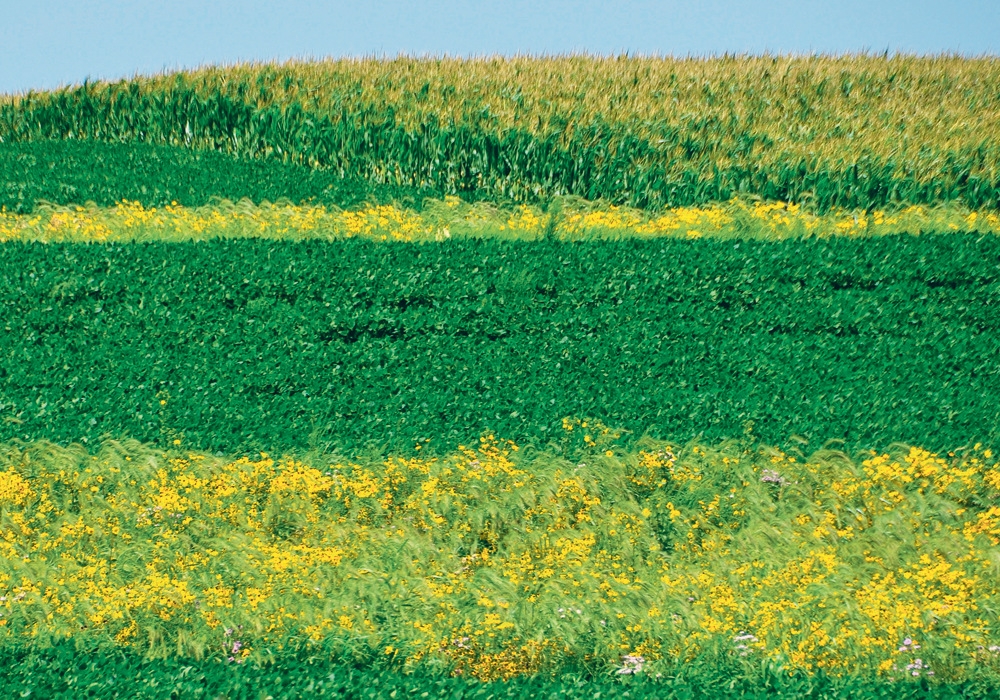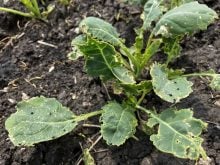Large monoculture fields often have isolated spots that don’t make farmers money, but the solution may be home grown
Large monoculture fields are the only efficient way to grow corn and soybeans, but one Iowa State University researcher thinks native prairie plants may have a fit in those fields.
Most fields on the northern Great Plains have areas that just don’t produce a profit. It’s easier to just farm straight through them rather than try to bottle feed them.
“Our research shows that areas of native prairie planted in the right places in a farm field can provide benefits far outweighing the loss from converting that small portion back to prairie,” says ISU researcher Lisa Schulte-Moore.
Read Also

Growing garlic by the thousands in Manitoba
Grower holds a planting party day every fall as a crowd gathers to help put 28,000 plants, and sometimes more, into theground
“For example, when we work with farmers to locate prairie strips in areas that were not profitable to farm, we can lower their financial costs while creating a wide variety of benefits.”
Schulte-Moore said most of the farmers who her team worked with were already well aware of the factors known as externalities, such as groundwater, pollinators, wildlife diversity and habitat. These things are usually sacrificed when crop yields are maximized.
She said work by her team shows that prairie strips may have the power to change that pattern. A prairie strip is pretty much what it sounds like — a strip of diverse herbaceous native vegetation located in a farm’s row crops.
The soil that now supports field crops In the U.S. Midwest and Canadian Prairies was covered by prairie plants before cultivation. The native prairie landscape was a mixture of native grasses, wildflowers and other stiff-stemmed plants. They had deep roots that draw water and nutrients from far below the surface.
Schulte-Moore is a member of Science-based Trials of Rowcrops Integrated with Prairie Strips (STRIPS), whose in-field research has shown that converting 10 percent of a row-cropped field to prairie strips had five distinct benefits:
- reduced soil loss by 95 percent
- reduced overland water flow by 37 percent
- reduced nitrogen loss by 70 percent
- reduced phosphorus loss by 77 percent
- greater abundance and diversity of beneficial insects and pollinators
“Some of these can benefit our pocketbooks but are not accounted for by typical financial markets,” she said.
“These include ecological benefits such as flood control, cleaner water and stored carbon from the atmosphere.”
STRIPS research began in 2007, and five years later, because of promising scientific results, the team began working with farmers to install prairie strips on commercial farms. While the research results have been variable in these more complicated settings, findings are encouraging, and co-operating farmers like what they see.
The plantings require a modest investment in site preparation and seeding. Maintenance tasks include mowing in the establishment years and spot treatment for weeds. The researchers have not seen competition between the prairie plants and crops that affect yield.
However, lack of stable financial rewards for establishing and maintaining prairie strips is a barrier to widespread adoption. Schulte-Moore is now focused on developing marketable products from prairie strips, such as renewable energy sources from biomass, honey production, fibre, livestock forage and hunting leases. More productive soil in the fields can, in time, translate into better yields
“Finding ways to return economic value to farmers and farmland owners is crucial.”
Schulte-Moore presented her research at last November’s meeting of the American Society of Agronomy and Crop Science Society of America in Baltimore.


















